Sold Ceramics
Sold Delft Faience 1640-1730 / Other Earthenware
Page 1
In the Sold Delft Faience 1640-1730 / Other Earthenware category the sold objects are categorized in the following order:
- Delft Faience 1640-1730
- Earthenware
Sold Delft Faience 1640-1730
Dishes like the following in Dutch called Kaapse schotels, were inspired by Chinese kraak porcelain from the 2nd quarter of the 17th century. These dishes illustrate that Delft factories were able to produce good quality wares similar to Chinese export porcelain. The original Chinese designs must have been very popular at the time.
These dishes were fired stacked in round tubes resting on narrow pins after the cooling down these pins caused only small flaws on the reverse side of the dishes as can be seen on this dish.
Copyright in bibliographic data and cover images is held by the publisher or by their respective licensors: all rights reserved.
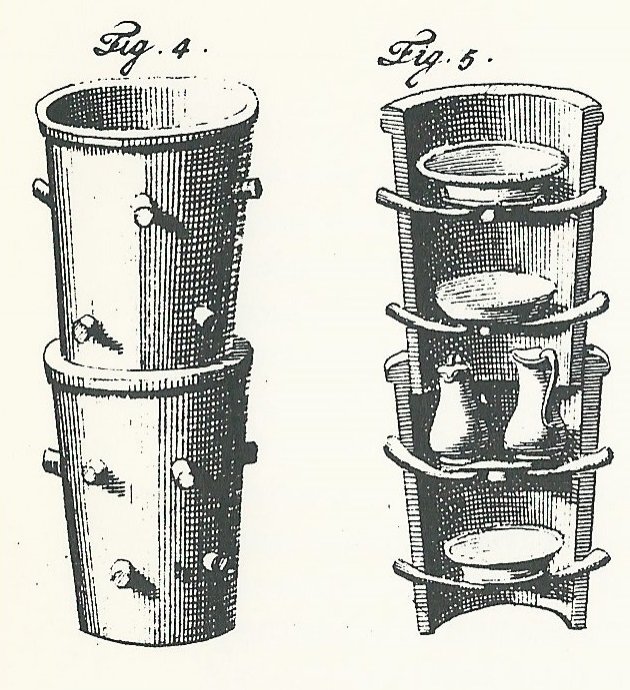
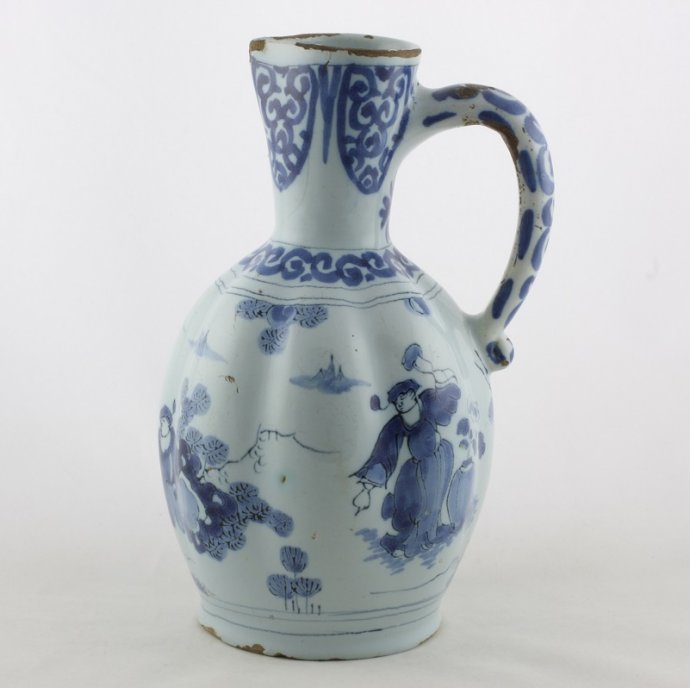
Sold Ceramics - Sold Delft Faience 1640-1730 / Other Earthenware - Delft Faience 1640-1730 - Page 1
Object 2011516
Ewer
Dutch (Delft)
1650-1680
Height 238 mm (7.83 inch), diameter 125 mm (4.33 inch), diameter of mouthrim 47 mm (1.10 inch), diameter of foot 89 mm (2.68 inch), weight 627 grams (22.12 ounce (oz.))
Earthenware ewer of ovoid ribbed body on spreading foot, cylindrical neck and a large mouth with a pinched spout. Curved handle. The shallow conical base is glazed and has a piece of lead attached. Decorated in different shades of blue on a white tin glaze in Chinese Transitional style with figures in a mountainous landscape with pierced rockwork, trees and flowering plants. Round the shoulder a leafy scroll border and on the neck pointed leaves filled with leafy scrolls. On the handle dots and scrolls.
On the underside of the top of handle the remains can be seen of the spot were once a mount was affixed to the ewer. This mount, responsible for the glaze rough spots to the mouthrim, is now missing. It is unclear what the function of the piece of lead attached to the base might have been. The base is still intact so it is not attached by a drilled hole to base but in another way.
In the period (1630-1645) the VOC (Dutch East India Company, 1602–1799) ordered Chinese porcelain through the Company's factory on Formosa (Taiwan). The Transitional style had been very popular in the Netherlands. As with kraak porcelain the decorative elements are taken from the repertoire of the Chinese Transitional style porcelain. After Chinese exports came to a standstill due to internal conflicts around 1647 the shapes and decorations of transitional porcelain were frequently imitated in Delft faience, this ewer is a good and rare example of those imitations copied by Delft potters. (Jörg 1984, p.14) & (Jörg 2011/1, p.123)
For a similarly shaped and decorated Chinese Transitional ewer, please see:
For a similarly shaped and decorated Japanese Arita ewer, please see:
For similarly shaped or decorated ewers, please see:
- Austrumu porcellans un Niderlande. Austrumu un Rietumu mijiedarbiba 17. gadsimta / Oriental Porcelain and the Netherlands. Interaction between East and West in the 17th century, (C.J.A. Jörg, Art Museum Riga Bourse, Riga, 2011), pp. 180-181, cat. 58.
- Antiek Delftsch, (P. Riccardijn, C. Morks Cz., Dordrecht), p.7.
Condition: Various glaze damage spots on the body, rim, handle and foot. A chip to the foot and a hairline to the mouthrim. Overall tiny scratches to the tin glaze due to use.
References:
Price: Sold.
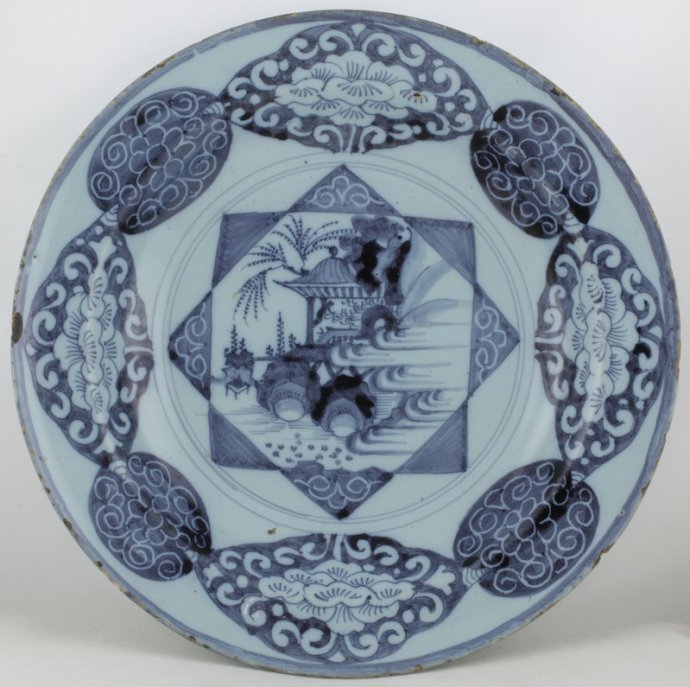
Sold Ceramics - Sold Delft Faience 1640-1730 / Other Earthenware - Delft Faience 1640-1730 - Page 1
Object 2012203
Dish
Dutch (Delft)
1660-1680
Height 42 mm (1.65 inch), diameter of rim 302 mm (11.89 inch), diameter of footring 150 mm (5.91 inch), weight 800 grams (28.22 ounce (oz.))
Earthenware dish on footring. flat rim. Decorated in different shades of blue on a white tin glaze with two superimposed shikishi on a blue ground, the one below in dark blue, the other with a a pavilion in a riverscape with clouds, trees and rocks. On the sides four large and four small medallions filled with a flower head and leafy scrolls on a blue ground. The reverse with three circles and three asterisks. The footring has been pierced.
The superimposed squares represent shikishi, special Japanese papers used for painting or calligraphy. This shikishi pattern was originally used in Japan as a decoration design on moulded dishes with scalloped rims. (Jörg 2003/1, p.38, cat. 21)
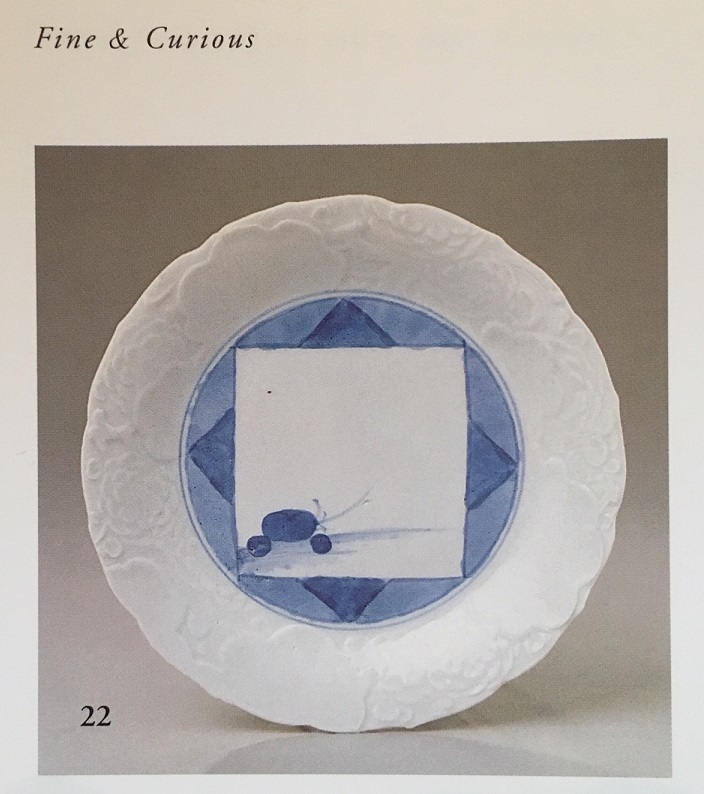
In his Fine & Curious on page 40, cat. 22 Jörg shows an example of this shikishi design pattern.
Reproduced from: Fine & Curious. Japanese Export Porcelain in Dutch Collections, (C.J.A. Jörg, Hotei Publishing, Amsterdam, 2003), p.40, cat. 22. This dish is not included in this sale/offer. (copyright in bibliographic data and images is held by the publisher or by their respective licensors: all rights reserved)
For examples of dishes decorated with this shikishi design pattern, please see:
- Fine & Curious. Japanese Export Porcelain in Dutch Collections, (C.J.A. Jörg, Hotei Publishing, Amsterdam, 2003), pp.38-40, cat. 21 & 22.
- Complete Catalogue of the Shibata Collection, (The Kyushu Ceramic Museum, Kyushu 2003), p.132, cat. 997 & 998.
Apparently the same shikishi design pattern was used on Delftware of c.1660-1680 proving that Japanese pieces with this design pattern were known in The Netherlands at that time. (Jörg 2003/1, p.38, cat. 21a)
For an identically shaped and similarly decorated Dutch (Delftware) dish, please see;
- Fine & Curious. Japanese Export Porcelain in Dutch Collections, (C.J.A. Jörg, Hotei Publishing, Amsterdam, 2003), p.38, cat. 21a.
Condition: Some minor frits and glaze chips to the rim.
References:
Jörg 2003/1, cat. 21, cat. 21a & cat. 22
Price: Sold.
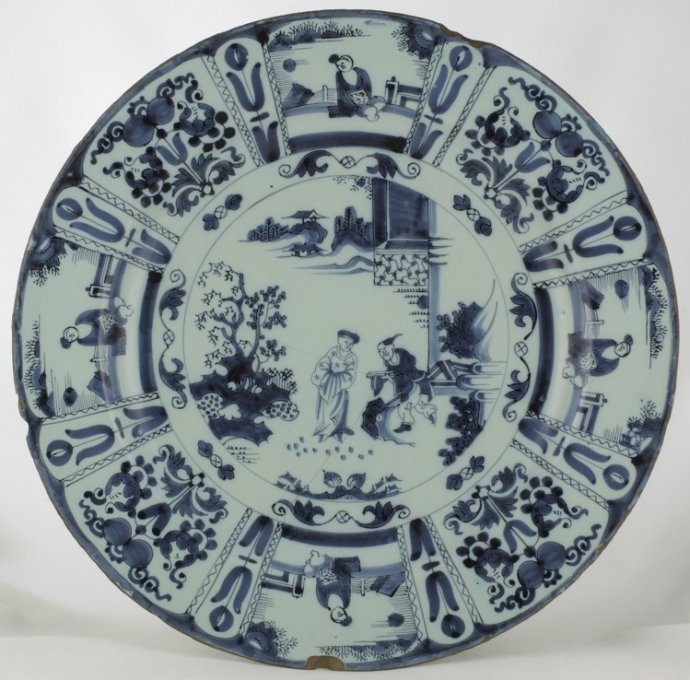
Sold Ceramics - Sold Delft Faience 1640-1730 / Other Earthenware - Delft Faience 1640-1730 - Page 1
Object 2012033
Dish
Dutch (Delft)
1660-1680
Provenance: Haffmans family art & antiques collection, Helden, The Netherlands.
Height 58 mm (2.28 inch), diameter of rim 400 mm (15.75 inch), diameter of footring 194 mm (7.64 inch), weight 1.852 grams (65.33 ounce (oz.))
Large earthenware dish on footring, flat rim. The footring has been double pierced. Decorated in different shades of blue on a white tin glaze in Chinese Transitional style with a standing figure and his servant in a garden landscape. Flower scrolls replace the diaper motif as a border around the centre medallion. On the sides eight large and eight narrow panels. The narrow panels are decorated with Dutch flowers, most likely tulips, four large panels are filled with a seated figure near a fence in a riverscape, the other four large panels are filled with Dutch flowers. On the reverse four circles and three asterisks. Marked on the base with the number '8'. Old paper with old hand writting is glued to the base in order to hold in place an old steel wire hanging construction.
Jan Alexander Haffmans (1795-1851) inherited Ooijen castle and its inventory near Broekhuizenvorst from his mother. Jan's grandson, notary Oscar Haffmans (1859-1933) and his son Frans Sr. (1893-1982) both added many antique objects to the family collection mainly purchased at auctions in which they were involved on a professional basis. For example it is known that in 1905 at the liquidation sale of the inventory of Well Castle Oscar purchased antique weapons and a blue and white Chinese porcelain service.
Villa 'Louise' at the Kesselseweg in Helden was build around 1890 as a residence for Eugène Haffmans (1864-1915) and his wife Louisa Gerrits (1869-1935). From 1919 until his death in 1982 the house was inhabitad by by a nephew from Eugène, the before mentioned notary Frans Haffmans Sr. (1893-1982) and his wife Katrien IJzermans (1897-1972). Katrien was born into a wealthy shipowners family from Vlaardingen, she decided to rename the house 'Het Zonnehuis'. When an unmarried distant family member of her died in the late 1940s many antique objects like Chinese and Japanese porcelain, crystal, Dutch earthenware and furniture came to the villa in Helden.
(I am indebted to Mr. F.J. Haffmans for this informtion)
Villa 'Louise' / 'Het Zonnehuis'
Frans Haffmans Sr. (1893-1982) and his wife Katrien IJzermans (1897-1972), drinking tea and having a conversation with a family member, just above the television we can see the dish hanging on the wall.
(image courtesy of Mr. F.J. Haffmans)
The peculiarity of this border is that it blends typical Chinese Kraak panelled borders with Transitional style motifs. The footring has been double pierced in order to fit a wire through it - the traditional Dutch way to hang dishes on walls as display pieces. (Rinaldi 1989, p.137)
For similarly Dutch (Delft) decorated dishes, please see:
Condition: A Y-shaped crack and various chips to the mainly unglazed rim.
References:
Lunsingh Scheurleer 1975, cat. 58
Rinaldi 1989, p.137, p.224, Pl. 285
Price: Sold.
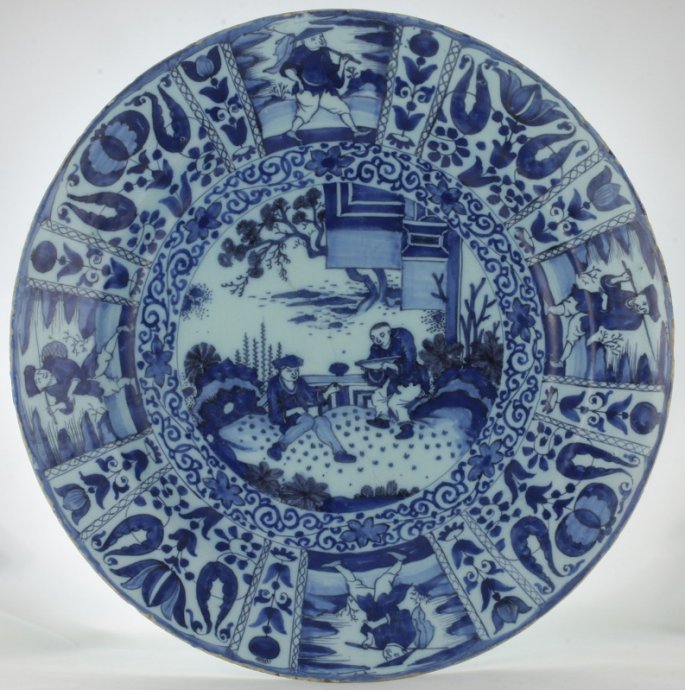
Sold Ceramics - Sold Delft Faience 1640-1730 / Other Earthenware - Delft Faience 1640-1730 - Page 1
Object 2010644
Dish
Dutch (Delft)
1660-1680
Height 67 mm (2.64 inch), diameter of rim 387 mm (15.23 inch), diameter of footring 133 mm (5.24 inch)
Large earthenware dish on footring with a flat rim. The footring has been double pierced. Decorated in different shades of blue on a white tin glaze in Chinese Transitional style with a seated figure and his servant in a garden landscape. Flower scrolls replace the diaper motif as a border around the centre medallion. On the sides eight large and eight narrow panels. The narrow panels are decorated with Dutch flowers, most likely tulips, four large panels are filled with a figure walking in a landscape near a shore, the other four large panels are filled with Dutch flowers. On the reverse nine circles.
The peculiarity of this border is that it blends typical Chinese Kraak panelled borders with Transitional style motifs. The footring has been double pierced in order to fit a wire through it - the traditional Dutch way to hang dishes on walls as display pieces. (Rinaldi 1989, p.137)
Condition: A professional restored crack and four chips to the rim.
References:
Lunsingh Scheurleer 1975, cat. 58
Rinaldi 1989, p.137, p.224, Pl. 285
Price: Sold.
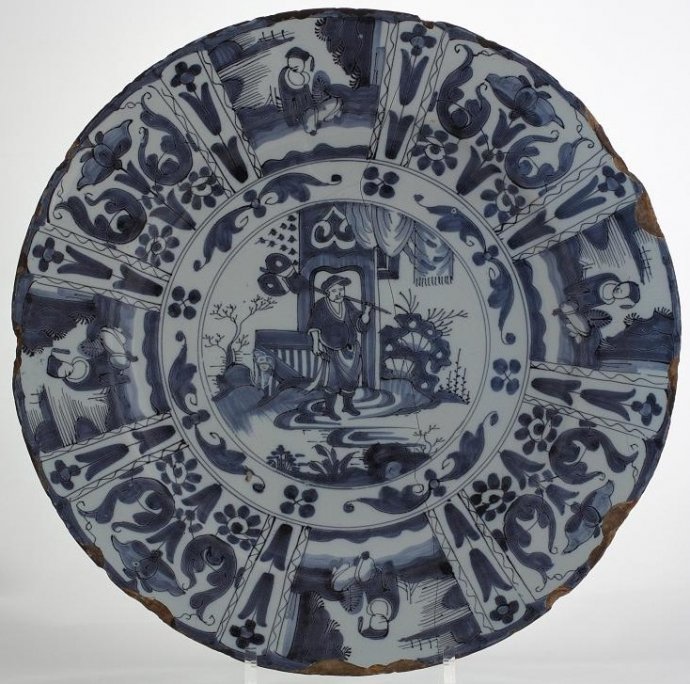
Sold Ceramics - Sold Delft Faience 1640-1730 / Other Earthenware - Delft Faience 1640-1730 - Page 1
Object 2010199
Dish
Dutch (Delft)
1660-1680
Height 53 mm (2.08 inch), diameter of rim 350 mm (13.77 inch), diameter of footring: 180 mm (7.08 inch)
Earthenware dish on footring with a flat rim. Decorated in different shades of blue on a white tin glaze in Chinese Transitional style with a figure holding a fan in a garden landscape. Flower scrolls replace the diaper motif as a border around the centre medallion. On the sides eight large and eight narrow panels. The narrow panels are decorated with Dutch flowers, most likely tulips, four large panels are filled with a figure sitting in a landscape near a shore, the other four large panels are filled with Dutch flowers. On the reverse three circles and three asterisks. Marked on the base with an axe.
The peculiarity of this border is that it blends typical Chinese Kraak panelled borders with Transitional style motifs. The footring has been double pierced in order to fit a wire through it - the traditional Dutch way to hang dishes on walls as display pieces. (Rinaldi 1989, p.137)
Condition: Restored and several chips around the rim.
References:
Lunsingh Scheurleer 1975, cat. 58.
Rinaldi 1989, p.220, Pl.279 & p.224, Pl. 285.
Price: Sold.
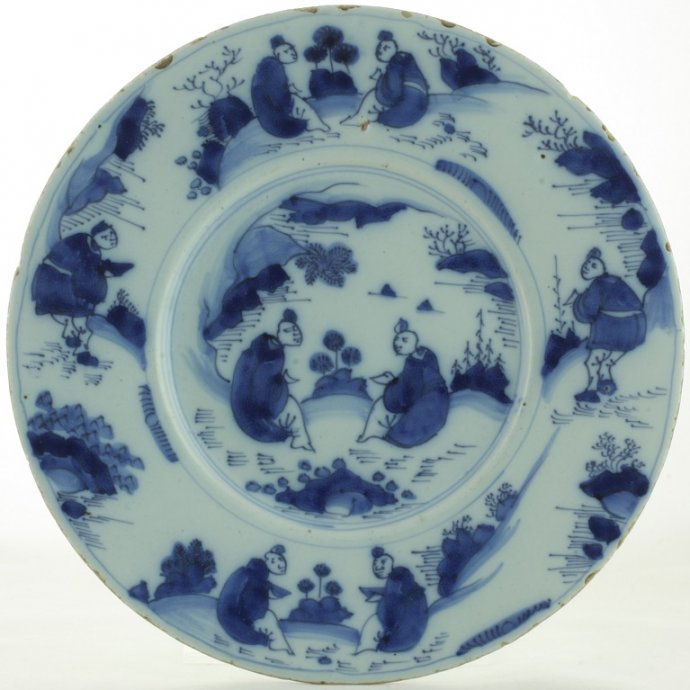
Sold Ceramics - Sold Delft Faience 1640-1730 / Other Earthenware - Delft Faience 1640-1730 - Page 1
Object 2011328
Dish
Dutch (Delft)
1660-1680
Height 25 mm (0.98 inch), diameter of rim 217 mm (8.54 inch), diameter of base 100 mm (3.94 inch), weight 321 grams (11.32 ounce (oz.))
Earthenware dish on footring with a flat rim. Decorated in different shades of blue on a white tin glaze in Chinese Transitional style with a river scape with two seated figures near a shore. The motif is repeated on the rim alternating with a figure walking in a garden landscape. The reverse is undecorated.
This dish has a typical chinoiserie decoration using elements of Chinese Transitional and early Kangxi porcelain. From 1585 to 1620 a number of potteries producing tin-glazed wares were opened in Delft. Shapes and decorative motifs were often borrowed from Venetian or Faentine originals. From 1620 to 1647 the large and regular supply of relatively inexpensive Chinese porcelains put a number of Delft potteries out of business. In order to survive, the others had to modify their production. Some potteries began to produce cheap copies of Chinese porcelain adopting Chinese motifs. These wares were as yet nowhere near the technical perfection the Delft potters achieved only a few years later. During the period 1660-1685 potteries were able to supply a wide range of items. Almost every factory produced pieces painted with their own interpretations of the decorations on the Chinese porcelain of the 1670s and 1680s, as well as objects that were decorated with all sorts of European subjects. (Rinaldi 1989, p.219)
The decoration on this dish is a typical Dutch (Delft) earthenware copy of a Chinese porcelain example. Until 1640 there was a regular supply of porcelain from China mainly consisting of kraak and Transitional objects. The decorative motifs were taken from woodblocks prints illustrating plays, histories, novels and dramas. For the Dutch the story behind the decoration was often irrelevant. It was the oriental and exotic character of the decoration that was relevant.
For similarly decorated Dutch (Delft) dishes, please see:
- Delfts Blauw, (D.F. Lunsingh Scheurleer, Bussum 1975), cat. 72.
- Delfts aardewerk in het Groninger Museum. (F.T. Scholten & C.J.A. Jörg, Groninger Museum, Groningen 1990), p.18, cat. 20.
- Austrumu porcellans un Niderlande. Austrumu un Rietumu mijiedarbiba 17. gadsimta / Oriental Porcelain and the Netherlands. Interaction between East and West in the 17th century, (C.J.A. Jörg, Art Museum Riga Bourse, Riga, 2011), pp.305-305, cat. 115.
For similarly decorated Dutch (Delft) dish, with the use of the colour purple, please see:
For a similarly decorated Dutch (Delft) tazza, please see:
For a similarly decorated Chinese dish, please see:
Condition: A firing flaw, some small glaze frits and chips to the rim. Most of the glaze of the rim has worn of.
References:
Lunsingh Scheurleer 1975, cat. 72
Price: Sold.
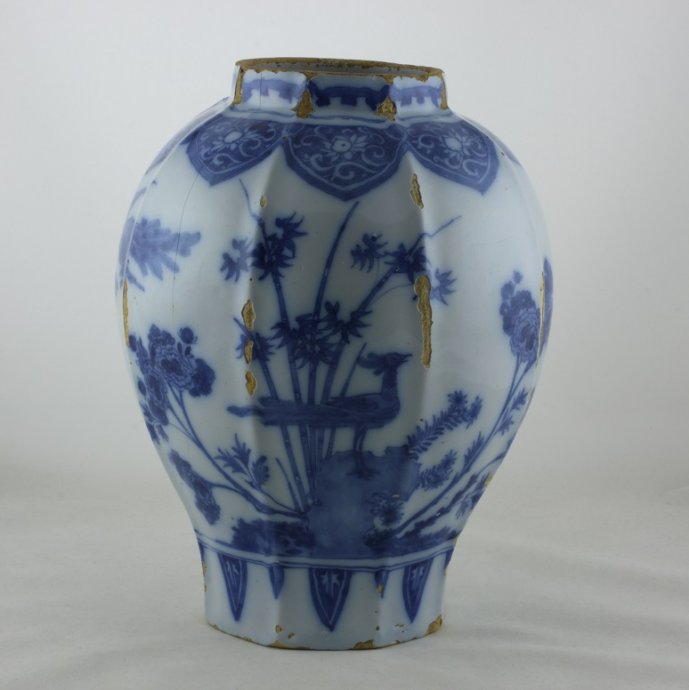
Sold Ceramics - Sold Delft Faience 1640-1730 / Other Earthenware - Delft Faience 1640-1730 - Page 1
Object 2012006
Baluster vase
Dutch (Delft)
1660-1680
Height 244 mm (9.61 inch), diameter of mouthrim 80 mm (3.15 inch), diameter foot 108 mm (4.25 inch), weight 1,454 grams (51.29 ounce (oz.))
Octagonal earthenware baluster shaped vase on a flat unglazed base. The original cover is missing. Decorated in different shades of blue on a white tin glaze in Chinese Transitional style with round the foot a pointed leaves pattern border. On the body a continuous scene with a bird perched on a rock flanked by flowering peony and bamboo plants, a bird in flight, groups of flowering plants and a peacock in flight. On the shoulder a pointed leaves pattern border, each leaf is filled with flowering lotus plants on a blue on white tin glaze ground. Around the neck a band of lappets. Marked on the base with the initial 'R'.
Often the decorative elements of Dutch (Delft) vases of this period are taken from the repertoire of the Chinese Transitional style porcelain. The Transitional style had been very popular in the Netherlands, after Chinese exports came to a standstill around 1647. Apparently the decorations on Japanese Arita vases were also used as a source of inspiration for the Dutch (Delft) decorators who imitated these decorations in Delft faience. This baluster vase is a good and rare example of one of these Japanese imitations. The decorative elements are on this vase are very similar to the decoration on object 2011949, a recently sold Japanese Arita baluster vase.
For a comparison of the decoration on both the Dutch (Delft) (2012006) vase and the Japanese Arita (2011949) vase please click on 'More pictures >>' below.
The initial 'R' on the base might refer to 'De Roos' - The Rose a Delft workshop active from 1661-1858.
Condition: Heavy glaze loss to the edges, corners and rim and a hairline to the rim.
Price: Sold.
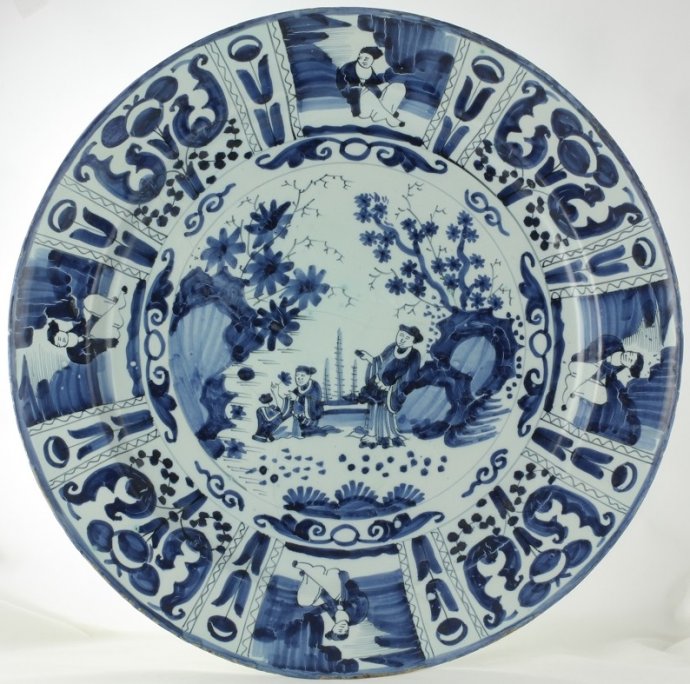
Sold Ceramics - Sold Delft Faience 1640-1730 / Other Earthenware - Delft Faience 1640-1730 - Page 1
Object 2011302
Dish
Dutch (Delft)
1670-1700
Height 63 mm (2.48 inch), diameter 405 mm (15.95 inch), diameter of footring 216 mm (8.50 inch), weight 1.566 grams (55.24 ounce (oz.))
Large earthenware dish on footring with a flat rim. Decorated in different shades of blue on a white tin glaze in Chinese Transitional style withwith two figures in a garden landscape, surrounded by a border with flowers and leaf sprays. The rim and sides divided into wide and narrow panels painted with seated figures in river landscapes and tulip motifs. The reverse is undecorated. The footring has been originally double pierced. On the base an old paper collectors label.
The peculiarity of this border is that it blends typical Chinese Kraak panelled borders with Transitional style motifs. The original Chinese dishes are now rare but were in 17th century more common and popular to copy by the Delft potters. The function of these large dishes varied from serving fruit or cake to being displayed on a wall therefore the original pierced footring was used to pull a wire through on which the dish could be hung. (Rinaldi 1989, p.137), (Jörg 2002/2, p.59)
For similarly decorated dishes, please see:
Condition: A restored crack and rim. Some of the glaze on the edge has peeled of.
References:
Lunsingh Scheurleer 1975, cat. 58
Scholten & Jörg 1990, cat. 11 & 12
Price: Sold.
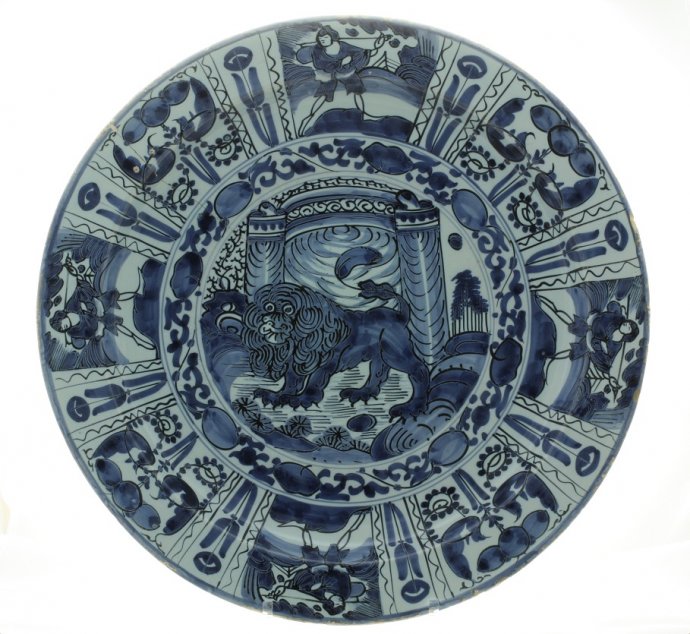
Sold Ceramics - Sold Delft Faience 1640-1730 / Other Earthenware - Delft Faience 1640-1730 - Page 1
Object 2010288
Dish
Dutch (Delft)
1670-1700
Height 60 mm (2.36 inch), diameter of rim 397 mm (15.63 inch), diameter of footring 220 mm (8.66 inch), weight 1.736 grams (61.24 ounce (oz.))
Earthenware dish on footring. flat rim. Decorated in different shades of blue on a white tin glaze in Chinese Transitional style with the so called 'Lion of Juda' in a garden landscape. Flower scrolls replace the diaper motif as a border around the centre medallion. On the sides and rim eight large and eight narrow panels. The narrow panels are decorated with Dutch flowers, most likely tulips, four large panels are filled with figure walking in a landscape near a shore, the other four large panels are filled with Dutch flowers. The reverse with four circles and four asterisks. The footring has been pierced.
The peculiarity of this border is that it blends typical Chinese kraak panelled borders with Transitional style motifs. The function of these large dishes varied from serving fruit or cake to being displayed on a wall therefore the original pierced footring was used to pull a wire through on which the dish could be hung. (Rinaldi 1989, p.137), (Jörg 2002/2, p.59)
On this specific dish the central decoration is known as 'The Lion of Juda' the arch, see sold object 2010387, was mistakenly identified as scrolls of prayer.
Condition: An old restored crack (clamped) and some glaze frits around the rim.
References:
Lunsingh Scheurleer 1975, cat. 58
Rinaldi 1989, Pl.110, Pl.279 & Pl.285
Price: Sold.
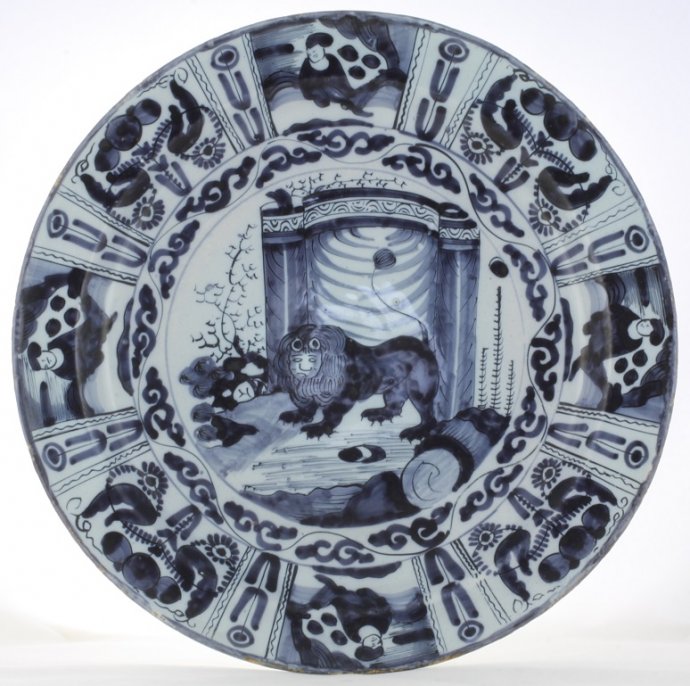
Sold Ceramics - Sold Delft Faience 1640-1730 / Other Earthenware - Delft Faience 1640-1730 - Page 1
Object 2011110
Dish
Dutch (Delft)
1670-1700
Height 56 mm (2.20 inch), diameter of rim 355 mm (13.98 inch), diameter of footring 177 mm (6.91 inch), weight 1.166 grams (41.24 ounce (oz.))
Earthenware dish on footring, flat rim. Decorated in different shades of blue on a white tin glaze in Chinese Transitional style with the so called 'Lion of Juda' in a garden landscape. Flower scrolls replace the diaper motif as a border around the centre medallion. On the sides and rim eight large and eight narrow panels. The narrow panels are decorated with Dutch flowers, most likely tulips, four large panels are filled with figure walking in a landscape near a shore, the other four large panels are filled with Dutch flowers. The reverse with four circles and four asterisks. The footring has been pierced.
The peculiarity of this border is that it blends typical Chinese kraak panelled borders with Transitional style motifs. The function of these large dishes varied from serving fruit or cake to being displayed on a wall therefore the original pierced footring was used to pull a wire through on which the dish could be hung. (Rinaldi 1989, p.137), (Jörg 2002/2, p.59)
On this specific dish the central decoration is known as 'The Lion of Juda' the arch, see object 2010387, was mistakenly identified as scrolls of prayer.
Condition: Three restored shallow glaze chips to the rim and some unrestored glaze frits around the rim. An old restoration to the pierced footring.
References:
Lunsingh Scheurleer 1975, cat. 58
Rinaldi 1989, Pl.110, Pl.279 & Pl.285
Price: Sold.
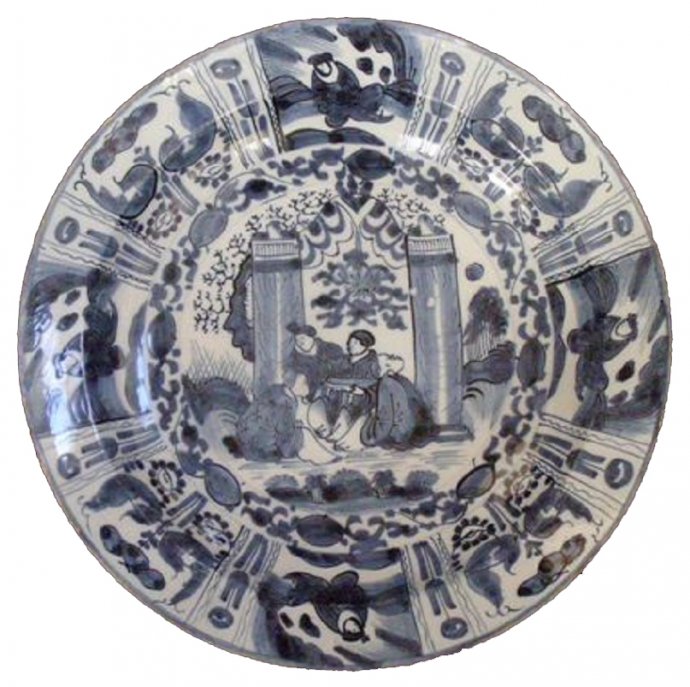
Sold Ceramics - Sold Delft Faience 1640-1730 / Other Earthenware - Delft Faience 1640-1730 - Page 1
Object 2010387
Dish
Dutch (Delft)
1675-1700
Height 50 mm (1.97 inch), diameter of rim 346 mm (13.62 inch), diameter of footring 180 mm (7.08 inch)
Earthenware dish on footring with a flat rim. Decorated in different shades of blue on a white tin glaze in Chinese Transitional style with four seated figures in a garden landscape. Flower scrolls replace the diaper motif as a border around the centre medallion. On the sides and rim eight large and eight narrow panels. The narrow panels are filled with Dutch flowers, most likely tulips, four large panels are filled with a figure sitting in a landscape near a shore, the other four large panels are filled with Dutch flowers. On the reverse six circles.
The peculiarity of this border is that it blends typical Chinese Kraak panelled borders with Transitional style motifs. The footring has been double pierced in order to fit a wire through it - the traditional Dutch way to hang dishes on walls as display pieces. (Rinaldi 1989, p.137)
For identically decorated dishes, please see:
Condition: Restored.
References:
Lunsingh Scheurleer 1970, cat. 30
Lunsingh Scheurleer 1975, cat. 58
Price: Sold.
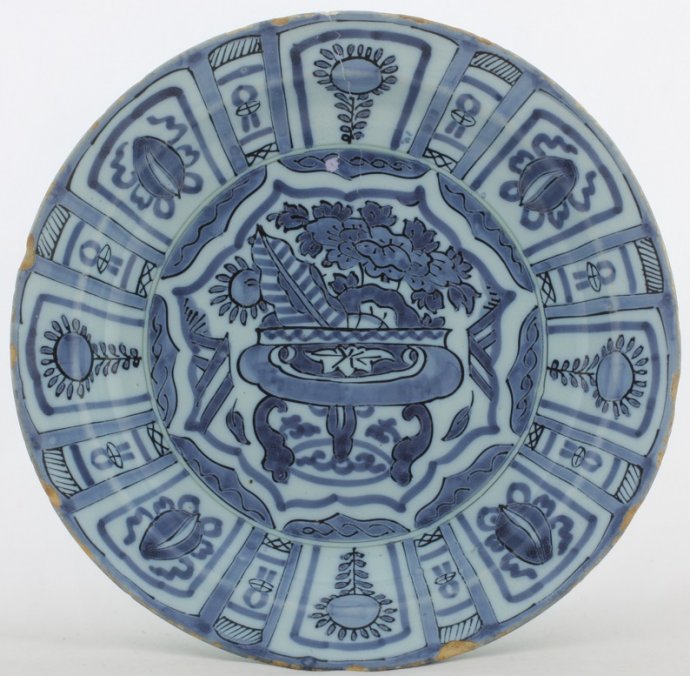
Object 2011496
Dish
Dutch (Delft)
1680-1700
Height 40 mm (1.57 inch), diameter of rim 251 mm (9.88 inch), diameter of footring 124 mm (4.88 inch), weight 467 grams (14.47 ounce (oz.))
Earthenware dish on footring, flat rim. Decorated in different shades of blue on a white tin glaze in Chinese kraak style with a flower basket on a stand with protruding roots growing from the base. The flower basket is filled with peonies, peach and an artemisia leaf and is encircled by an eight pointed scalloped medallion. The rim and sides are divided into eight wide panels filled with peaches/sun flowers and artemisia leafs with tassels and eight narrow panels with tassels. On the reverse four circles and four stripes.
Faience is earthenware that is more thinly potted than majolica and both sides of dishes and plates are covered with a white tin glaze. Usually, such wares were made in moulds and fired in protective cassettes. It convincingly imitated the appearance of porcelain, although early wares mostly show European designs. When Chinese porcelain became scarce, in the 1640s, faience painted in blue with decorations imitating those on kraak and transitional wares was a welcome substitute. It was mainly produced in the city of Delft, hence the name 'Delft Blue'. It became highly popular, was exported throughout Europe and added to the glory of the 'Dutch Golden Age'. (Jörg 2011/1, p.289)
The dish is decorated in the style of Chinese kraak porcelain from the 2nd quarter of the 17th century.
For a similarly decorated Chinese dish please see:
Condition: A rough rim with various glaze chips. A crack and a hairline to the rim. Old restorations to the crack, a filled hole and a single shallow chip. A firing flaw and crazing to the glaze on the base.
References:
Price: Sold.
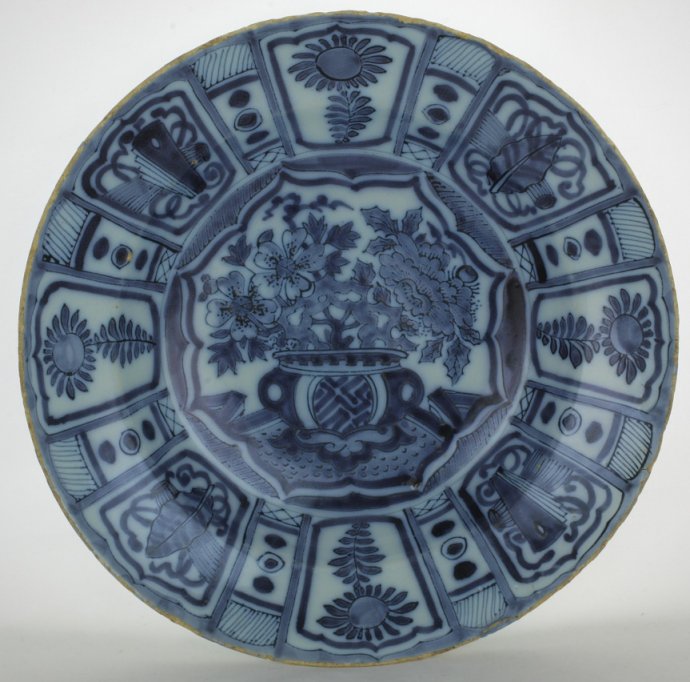
Sold Ceramics - Sold Delft Faience 1640-1730 / Other Earthenware - Delft Faience 1640-1730 - Page 1
Object 2010598
Dish
Dutch (Delft)
c.1700
Height 43 mm (1.69 inch), diameter of rim 245 mm (9.65 inch), diameter of footring 115 mm (4.53 inch)
Earthenware dish on footring with a flat rim. The footring has been pierced. Decorated in different shades of blue on a white tin glaze in Chinese kraak style with a flower basket, filled with a flowering peony and chrysanthemum plants encircled by an eight pointed scalloped medallion. On the sides and rim large panels filled with sunflowers and symbols and narrow panels filled with dots. On the reverse three circles and asterisks.
The footring has been pierced in order to fit a wire through it - the traditional Dutch way to hang dishes on walls as display pieces. This dish is decorated in a way Chinese kraak porcelain of the 2nd quarter of the 17th century was decorated. It was made at the end of the 17th century, begin 18th century when Chinese originals could no longer be obtained. (Rinaldi 1989, p.137)
For a similarly decorated original Chinese "Kraak" dish, please see:
Condition: Two hairlines to the rim, a chip to the pierced hole in the footring, a glaze firing flaw (wrinkled) to the reversel and an overall rough rim.
Reference:
Price: Sold.
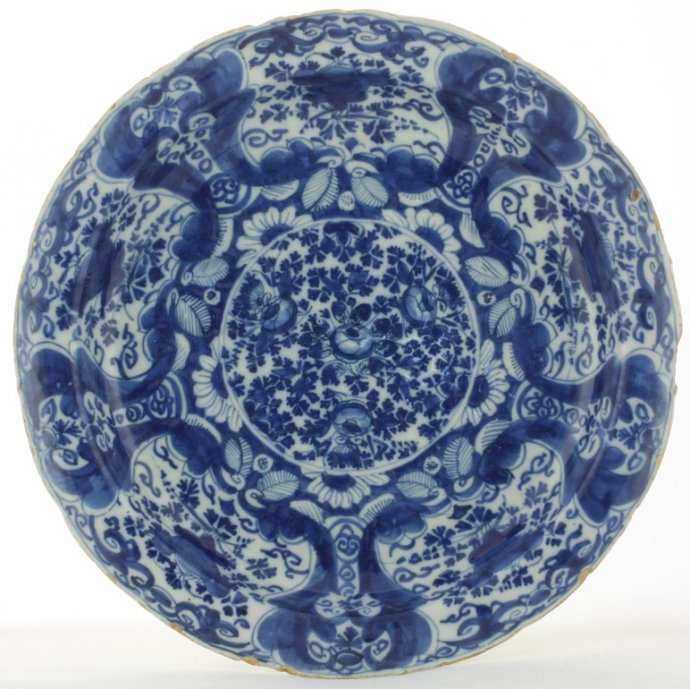
Sold Ceramics - Sold Delft Faience 1640-1730 / Other Earthenware - Delft Faience 1640-1730 - Page 1
Object 2011275
Dish
Dutch (Delft)
c.1700
Height 38 mm (1.49 inch), diameter of rim 225 mm (8.86 inch), diameter of footring 102 mm (4.02 inch)
Earthenware dish on footring with a flat rim. Decorated in different shades of blue on a white tin glaze with various blooming flowers in a double concentric band. On the rim five medallions in Chinese kraak style filled with blooming flowers. On the reverse five simple flowers.
For an identically decorated dish, please see:
Condition: Two firing flaws, two hairlines, two chips and some minor glaze fritting around the rim. A chip and two frits to the inner footring.
Reference:
Lunsingh Scheurleer 1975, cat. 69
Price: Sold.
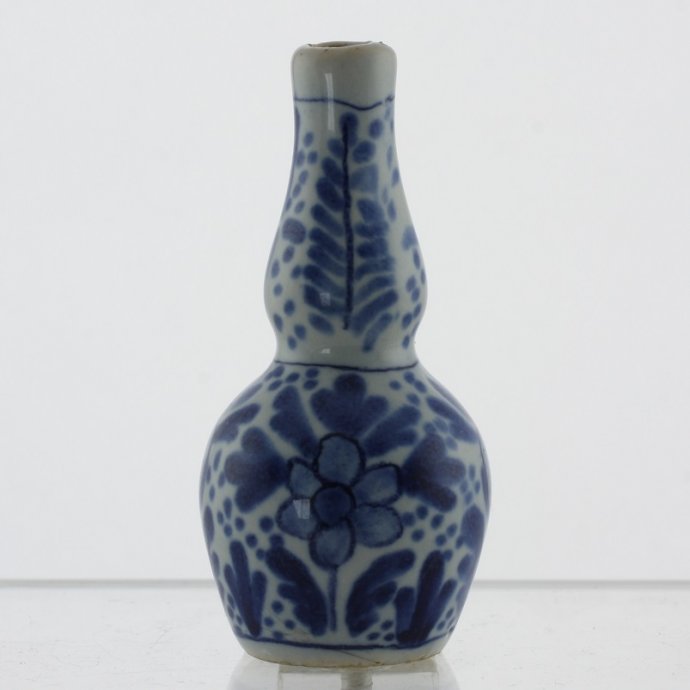
Sold Ceramics - Sold Delft Faience 1640-1730 / Other Earthenware - Delft Faience 1640-1730 - Page 1
Object 2010682
A miniature 'doll's house' vase
Dutch (Delft)
c.1700
Height 50 mm (1.97 inch), diameter 22 mm (0.86 inch), diameter of mouthrim 6 mm (0.24 inch), diameter of footring 15 mm (0.59 inch)
Earthenware miniature double-gourd "doll's house" vase on a flat tin-glazed base. Decorated in different shades of blue on a white tin glaze with various flowering plants. On the neck leafy branches alternating with groups of dots. Marked on the base: 'TT'.
This rare earthenware small double-gourd miniature 'doll's house' vase, is an exact Dutch copy (form and decoration) of a Chinese export porcelain miniature 'doll's house' vase. At the beginning of the 18th century, there was a fashion among wealthy Dutch ladies to have models made on the scale of a house, the so called "doll's houses". The rooms of these doll's houses were furnished with miniature pieces of porcelain, furniture, paintings, upholstery and all other sorts of objects that would have belonged to the interior of a wealthy home. These doll's houses were very costly and certainly not meant for children to play with but were proudly displayed for friends and visitors and regarded as extremely luxurious items - counterparts of the cabinets of curiosities that were a fashionable hobby of rich men. Only a few of these doll's houses have been preserved. One example can be found in the Gemeentemuseum in The Hague showing an 18th century room with porcelain miniatures in cupboards and on brackets along the wall. In reality the majority of these "miniature doll's house vases" would have been part of the interior. A good example of an authentic porcelain room is the famous cabinet in Pommersfelden Castle, Germany, where groups of pieces on brackets are surrounded by these miniature vases lining the borders of the consoles. (Jörg & Flecker 2001, pp.50-51)
Condition: A tiny glaze frit and a short hairline to the rim.
Reference:
Price: Sold.
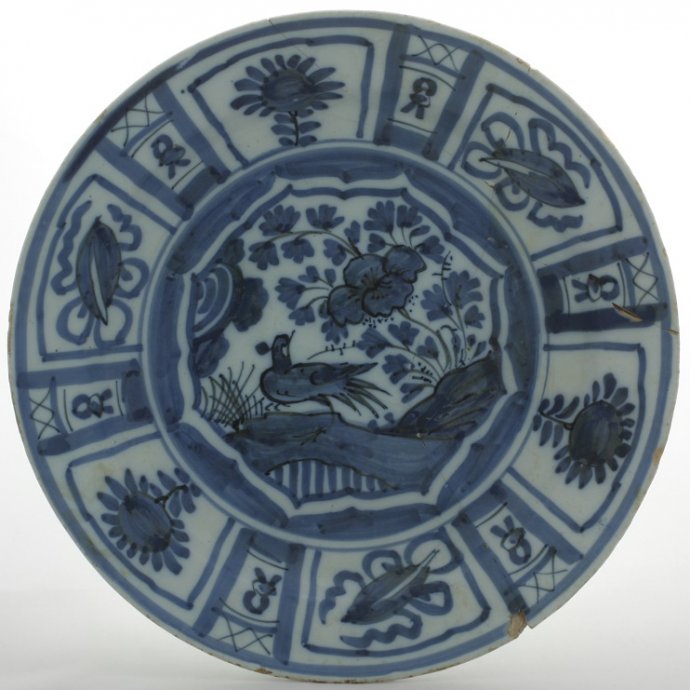
Sold Ceramics - Sold Delft Faience 1640-1730 / Other Earthenware - Delft Faience 1640-1730 - Page 1
Object 2010249
Dish
Dutch (Delft)
1700-1720
Height 31 mm (1.22 inch), diameter of rim 210 mm (8.27 inch), diameter of footring 115 mm (4.53 inch), weight 296 grams (10.44 ounce (oz.))
Earthenware dish on footring, flat rim. Decorated in different shades of blue on a white tin glaze in Chinese kraak style with a bird sitting on a rock in a marsh landscape with flowering peonies and clouds in a centre octagonal medallion. On the sides and rim six broad panels containing peaches and artemisia leaves and six narrow panels filled with tassels. The reverse is undecorated. The footring has been double pierced.
The dish is decorated in a way Chinese kraak porcelain of the 2nd quarter of the 17th century was decorated. Holes have been drilled in the very short footring in order to fit a wire through it - the traditional Dutch way to hang dishes on walls as display pieces. (Rinaldi 1989, p.137)
The dish was excavated in four pieces in the 1980's in Alkmaar (the Netherlands). The pieces were buried for about 330 years which is why they have been preserved so well even the two (!) original pierced holes in the footring have remained in perfect condition. The dish has been restored and now looks exactly the same as it did 330 years ago.
For a similarly decorated, original Chinese kraak dish, please see:
Condition: Restored out of four pieces, a chip to the rim, a missing piece of glaze on the interior wall and some tiny glaze frits to the rim.
Reference:
Price: Sold.
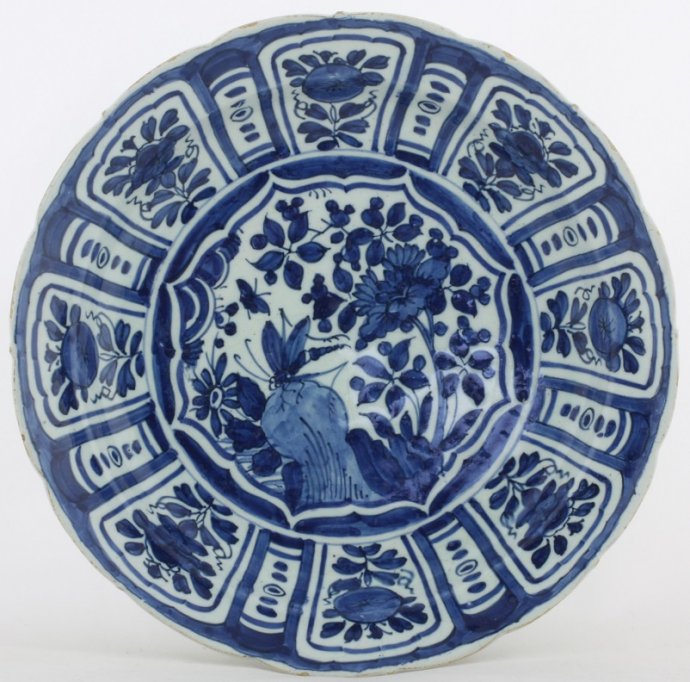
Sold Ceramics - Sold Delft Faience 1640-1730 / Other Earthenware - Delft Faience 1640-1730 - Page 1
Object 2011050A
Dish
Dutch (Delft)
1700-1730
Height 40 mm (1.57 inch), diameter of rim 257 mm (10.00 inch), diameter of footring 115 mm (4.53 inch), weight 449 grams (15.84 ounce (oz.))
Earthenware dish on footring with a flat rim. On the reverse four flaws. Decorated in different shades of blue on a white tin glaze in Chinese kraak style with an insect perched on a rock in a marsh landscape with water, rocks and flowering plants encircled by an eight pointed scalloped medallion. The sides with eight large panels filled with stylised sunflowers alternating with flowering peony and eight narrow panels filled with beaded pendants. The reverse is undecorated.
Faience is earthenware that is more thinly potted than majolica and both sides of dishes and plates are covered with a white tin glaze. Usually, such wares were made in moulds and fired in protective cassettes. It convincingly imitated the appearance of porcelain, although early wares mostly show European designs. When Chinese porcelain became scarce, in the 1640s, faience painted in blue with decorations imitating those on kraak and transitional wares was a welcome substitute. It was mainly produced in the city of Delft, hence the name 'Delft Blue'. It became highly popular, was exported throughout Europe and added to the glory of the 'Dutch Golden Age'. (Jörg 2011/1, p.289)
Dishes like these, in Dutch called Kaapse schotels, were inspired by Chinese kraak porcelain from the 2nd quarter of the 17th century. The dish illustrates that Delft factories were able to produce good quality wares similar to Chinese export porcelain. The original Chinese design must have been very popular at the time. Besides on this Dutch Delft dish it can also be found on Japanese Arita wares of the 4th quarter of the 17th century.
These dishes were fired stacked in round tubes resting on narrow pins after the cooling down these pins caused only small flaws on the reverse side of the dishes as can be seen on this dish.
For a similarly decorated Chinese dish please see:
For a similarly decorated Japanese dish please see:
Condition: Some very shallow glaze rough spots and three hairlines to the rim.
Reference:
Price: Sold.
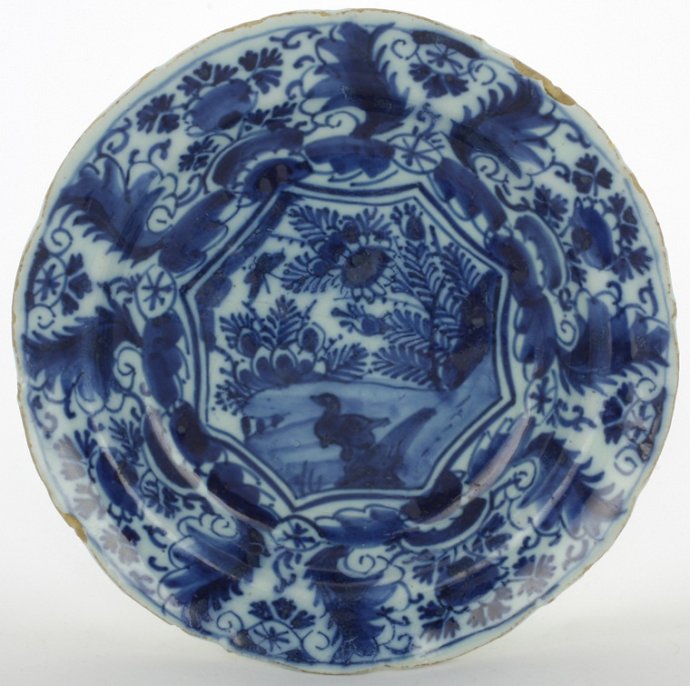
Sold Ceramics - Sold Delft Faience 1640-1730 / Other Earthenware - Delft Faience 1640-1730 - Page 1
Object 2010422
Saucer
Dutch (Delft)
1700-1750
Height 18 mm (0.71 inch), diameter of rim 128 mm (5.03 inch), diameter of footring 55 mm (2.17 inch)
Earthenware saucer on footring with a flat rim. Decorated in different shades of blue on a white tin glaze in Chinese kraak style with a duck in a marsh landscape with flowering plants, rocks and a butterfly in an eight pointed scalloped medallion. On the sides and rim with flower heads and leafy branches. The reverse is undecorated.
Condition: Three tiny glaze chips, glaze fritting and a hairline to the rim.
Price: Sold.
Sold Other Earthenware
Currently there are no Sold Other Earthenware objects.


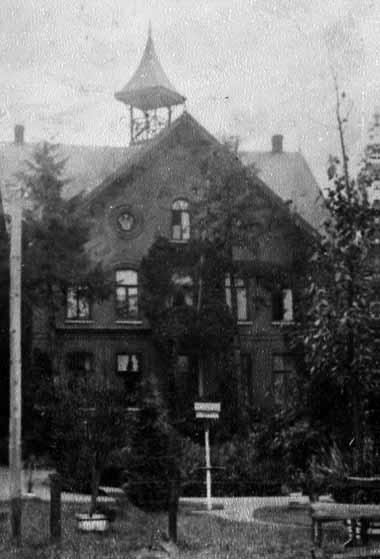
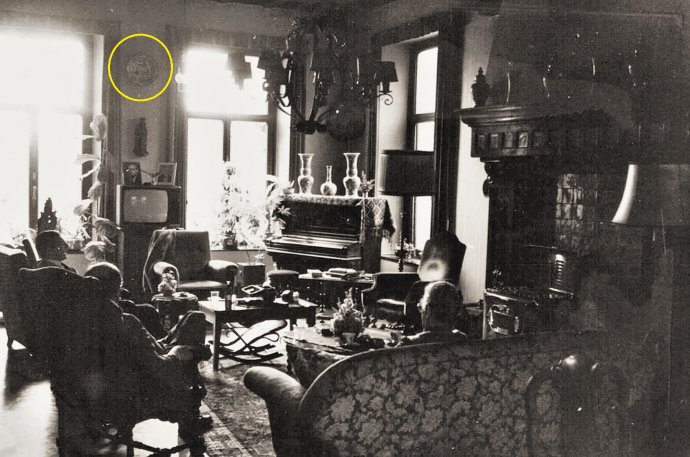
 create websites
create websites